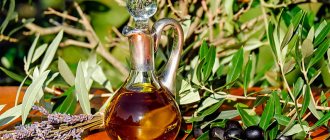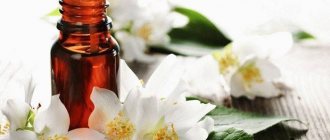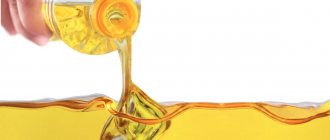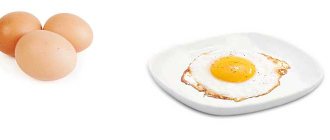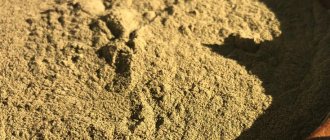Aromatherapy - essential oils: table of properties and applications
Essential oils are a topic that is gaining increasing popularity, because in recent years there has been a growing interest in the use of natural substances in various areas of life.
They are fragrant products of secondary plant metabolism and are widely used in folk medicine, the food industry as flavoring agents, in the cosmetic and perfume industry, and many are confident in their magical properties.
Over the last decade alone, more than 500 studies have been conducted to study the properties and applications of essential oils
Now we will study the most interesting, mysterious and even magical properties of essential oils, their areas of application, and for ease of perception, we will summarize some of the information in tables.
Types of essential oils
For thousands of years, mankind has known the antimicrobial and antibacterial capabilities of essential oils. Even in the Bible there are references to essential oils such as laurel, myrtle, frankincense, and sandalwood. They are also mentioned in the works of the great healers of the past, Hippocrates and Avicenna.
Over the last decade alone, more than 500 studies have been conducted to study the properties and areas of application of essential oils and aromatherapy; their results have been published, systematized in tables and available for study by everyone.
So what are the different types of oils?
For thousands of years, the antimicrobial and antibacterial capabilities of essential oils have been known to mankind.
By extraction method
Without identifying the main varieties and subspecies, it makes no sense to study such a broad issue as essential oils: properties and applications. The table below shows their varieties by extraction method.
Source of extraction Type of oil Berry Cloves, allspice, juniper. Wood Camphor, sandalwood, rosewood. Seeds Nutmeg, sandalwood, anise, celery, cumin. Bark Cinnamon, Cassia (Chinese cinnamon), a relative of Laurel sassafras. Rhizomes: Ginger, Potentilla erecta (Kalgan). Myrrh resin, frankincense, styrax wood, benzoin. Valerian root. Bay leaves, basil, sage, eucalyptus, patchouli, pine, mint, thyme, rosemary, lemongrass, cinnamon, tea tree, oregano, buchu. Peel Orange, tangerine, lemon, grapefruit, lime, bergamot. Inflorescences Orange, clary sage, chamomile, hemp, jasmine, hops, lavender, ylang-ylang, marjoram, damask rose.
Advice! Note that different types of oils can be extracted from the same plant, such as sandalwood. Add just a few drops of it to a tablespoon of olive oil and massage into the skin. This mixture has wonderful anti-aging properties.
Essential oils are obtained in various ways:
- distillation (from leaves and bark) - separation into fractions and evaporation of the liquid component;
- extraction (from inflorescences, petals and roots). In special extractor devices, the raw materials are combined with a special extractant substance, which is then removed, leaving pure, high-quality essential oil;
- pressing (from peels and fruits) - mechanical pressing.
Essential oils are obtained in various ways
according to the nature of the effect on humans
Through observation, people have determined the ability of these volatile compounds to affect our body in different ways. This explains the diverse, sometimes downright magical properties of essential oils and their scope of application. The table below shows the most interesting of them.
It has been noted that the smells of certain herbs, flowers and seeds relieve fatigue, the consequences of stressful situations and neuroses. There are fragrances to awaken passion, lift your spirits, and combat feelings of fear. And there are essential oils that have their own magic (they are also present in our table), their properties and scope of application are more unique, they are used to restore such subtle matter as the aura, in case of damage caused by someone else’s ill will and envy.
Advice! Drop just a couple of drops of chamomile oil on a table lamp, and soon a wonderful, rich aroma will spread throughout the room, giving a feeling of peace, promoting thought and meditation.
Physical Harmony
Smells, affecting certain areas of the brain, affect all human organs and systems.
Table: classification of fragrances by medicinal effect
| Effect of esters | Oils |
| Pain relief | lavender, rosemary, mint, eucalyptus, basil, tea tree |
| Affect blood pressure | · lowering blood pressure - geranium, cloves, juniper, fennel, lavender; Increase blood pressure - sage and thyme |
| Relieves cramps | cloves, juniper, nutmeg |
| Relieves spasms | lemon, mint, basil, cypress, rosemary |
| Stimulates physical and mental activity | bergamot, lavender, lemon, orange, fir, cloves |
| Are adaptogens | lemon balm, mint, lavender |
| Calm down | sandalwood, oregano, neroli, anise |
| Disinfect the room | conifers, cloves, sage, thyme, tea tree |
| Relieves depression | lemon balm, patchouli, orange, rose, jasmine, bergamot, sage |
| Restore immunity | anise, fir, lemon, pine, basil, ylang-ylang |
| Have a beneficial effect on the heart, blood vessels, autonomic and central nervous systems | geranium, lavender, rosemary, neroli, mint |
| Harmonize the sexual sphere | sandalwood, nutmeg, patchouli, ylang-ylang, petit grain, pine |
| Affect emotions | oregano, mandarin, mimosa, jasmine, rose, marjoram |
Essential oils are beneficial for skin and hair. They must be used carefully to avoid skin burns and allergic reactions from incorrectly selected odors.
Table: cosmetological effect of esters
| Action | Essential oil |
| chamomile, sandalwood, geranium, rosewood, vetiver |
| juniper, wormwood, jasmine, rosewood, neroli |
| mint, tea tree, bergamot, lavender, lemon |
| grapefruit, tea tree, juniper, lavender |
| rose, sandalwood, jasmine, rosewood, geranium, chamomile |
| incense, pine, myrrh, sandalwood, rose |
| Caring for dry hair | neroli, jasmine, lavender, geranium, juniper |
| Suitable for oily hair | grapefruit, cedar, patchouli, ylang-ylang |
| Strengthens hair and protects against hair loss | Tea tree, pine, myrrh, nutmeg, thyme, frankincense, sandalwood, bergamot |
| Accelerate growth | coniferous and citrus fruits |
| Get rid of dandruff | Citrus fruits, eucalyptus, incense, lavender in collaboration with base oils - cedar, castor or burdock |
Medicinal and cosmetic properties
The spectrum of biological activity of essential oils is very wide. Some of them are excellent antispasmodics, relieve headaches, others are antiseptics, they are recommended for treating wounds and cuts on the skin, there are oils for calming and, conversely, stimulating the nervous system and stimulating mental activity.
The spectrum of biological activity of essential oils is very wide. Some of them are excellent antispasmodics, relieve headaches, others are antiseptics, they are recommended for treating wounds and cuts of the skin.
Moreover, almost any of them are classified as potent drugs that can provide both help and harm, if the recommendations for use are not strictly followed. Therefore, such a question as essential oils: properties and application requires careful and methodical study. The table below will help make this difficult task easier (positions marked with an “*” should not be used in the sun).
Advice! After cutting yourself, apply diluted lavender oil to the wound. You will be pleasantly surprised by the speed of wound healing.
Features of the use of essential oils
The easiest way to make an essential oil safe for use is to dilute it with water. When carrying out cosmetic and medical procedures, it is most often necessary to mix the oil with a base, which can be milk, honey, wax, cream, lotion, but most often it is another transport oil. They call a number of vegetable oils that have both solid (shea butter) and liquid texture (olive, sea buckthorn, coconut, almond and others). The purpose of the transport oil is to ensure the penetration of the essential oil into the skin to ensure a therapeutic effect.
Advice! To avoid burns, do not use essential oils in pure, undiluted form, especially for children, unless otherwise indicated in the recommendations for use. Pregnant women and people with allergies should also avoid aromatherapy.
When carrying out cosmetic and medical procedures, it is most often necessary to mix the oil with a base, which can be milk, honey, wax, cream, lotion, but most often it is another transport oil
Most often, essential oils are used for the following procedures:
- baths and saunas;
- massages;
- inhalation;
- compresses;
- improvement and enrichment of cosmetic preparations;
- aromatherapy using lamps and stones;
- aroma pendants.
The properties of essential oils contain special magic, so that their use does not turn out to be harmful, use the dosage table.
Let's take a closer look at the most common uses of essential oils.
Baths and baths
Nothing better helps you relax after a hard day at work than taking a bath with aromatic oil.
To relieve stress and create a pleasant, relaxed state, use sandalwood, lavender, geranium or rose oil. After working hard in the gym, tense muscles also need relaxation; for this purpose, use juniper or verbena oil. Lemon or pine oil will help cure an incipient cold.
Nothing better helps you relax after a hard day at work than taking a bath with aromatic oil.
When mixed, the properties and characteristics of essential oils open up new facets. Using them according to the schemes given in the table, you will achieve an excellent cosmetic effect.
Description of the problem Oils used Presence of excess weight Mix a few drops (no more than 5) of oils: nutmeg, pine, rosemary, juniper, tangerine, lemongrass. Prepare a mixture of 5 drops of juniper and no more than 2 drops of lemon, cypress, and orange. “Orange peel” (cellulite) Prepare a mixture of juniper, grapefruit (3 drops each), lemon (4 drops), pine (5 drops) oils. Mix the following oils: orange, tangerine (3 drops each), rosemary (4 drops), bergamot (5 drops). Take 6 drops each of neroli, sandalwood and limmet. Stretch marks Mix a few drops of your choice (no more than 5 each) of the following oils: rosemary, grapefruit, geranium, frankincense, mint, hyssop, neroli, fennel, tea tree. Rules for creating aromatic baths:
- Clean the skin with a hard sponge.
- The water should not be too hot, optimally up to 38C.
- The base for the mixture can be kefir, whey, natural sea salt, honey, any transport oil, milk.
- When taking an aroma bath, do not use shampoos, shower gels, lotions and other cosmetics.
- The duration of the aroma bath should not exceed 25 minutes, and the procedure is carried out no more than three times a week.
- After finishing your aroma bath, allow your body to dry naturally; do not dry yourself with a towel.
In a bath or sauna, it is recommended to add essential oil directly to a ladle of water, which is subsequently poured onto the hot stones. For these purposes, they usually use some kind of pine oil; if desired, you can moisten brooms by mixing essential and transport oil.
Essential oil massage
Massage is undoubtedly useful for getting rid of many health problems, maintaining a figure, eliminating cellulite, treating after various types of injuries; essential oils will help enhance its effect. Moreover, depending on the selected component, its effect will differ.
Advice! Take clove essential oil with you to your massage session, it will increase blood circulation and speed up the warming up process, orange oil will help break down fatty tissue, sandalwood has a lifting effect, and nutmeg oil will relieve rheumatic pain.
Massage is undoubtedly useful for getting rid of many health problems, maintaining a figure, eliminating cellulite, treating after various types of injuries, essential oils will help enhance its effect
Rules for massages using essential oils:
- When choosing an oil for a massage session, evaluate not only its therapeutic properties, but also its smell; it should be pleasant to you, not irritate or cause unpleasant associations.
- After completing the massage session, spend about a quarter of an hour in a relaxed atmosphere, do not immediately run outside to meet new tasks and problems.
- During a massage with essential oils, preference is given to soft circular movements.
- To create a massage mixture, use a few drops of essential oil (no more than 5) and 1 tablespoon of base oil, which can be olive, almond, coconut, or apricot.
Classification according to the Eastern model
Typology by elements. Ayurveda and TCM (traditional Chinese medicine), of which aromatherapy is an important part, are based on the philosophy of the elements.
The aromas were divided into fougere, chypre, amber, fruit, leather, resinous, green , etc. (classification by family). But not only that, there are characteristics based on bodily/temperature sensations: cold, hot, neutral . The training of the nose gives this understanding, as well as the sensation of wet and dry aroma. Of course, these are quasi-sensations, but they clearly describe the effect of the oil.
Oils are characterized as either warming or cooling . This classification works on an intuitive level. A person chooses oils that currently resonate with his condition, without analyzing the cold or warmth he needs. What is this if not a characteristic of the elements from the eastern model!
Inhalation
A common, generally accepted and popular method of treating colds is inhalation. This procedure improves the drainage function of the body, reduces the inflammatory process, reduces swelling, and improves blood flow to the mucous membrane.
Preventive inhalations have the following properties:
- stimulation of local and general immunity;
- improvement of psycho-emotional state;
- stimulation of mental activity;
- lifting your spirits;
- antibacterial, antiviral effects;
- acceleration of regeneration.
Hot inhalation with essential oil is an effective remedy for colds
There are two types of inhalations:
- Cold, when the essential oil is dripped onto the corner of a pillow, napkin, fabric, and the inhalation process itself is carried out by inhaling the released aroma. The duration of the procedure is no more than 5 minutes.
- Hot, using a special device - an inhaler. A few drops of the selected essential oil are dripped into a special container filled with hot water, after which you need to inhale the released steam, covering yourself with a towel and closing your eyes.
Advice! If a child refuses to perform the hot inhalation procedure, drop 1-2 drops of essential oil on the corner of his pillow.
One of the methods of cold inhalation, especially relevant during epidemics of various colds, is the use of an aroma pendant made of porous clay.
One of the methods of cold inhalation, especially relevant during epidemics of various colds, is the use of an aroma pendant made of porous clay
Sage
This is an oil with a tart musky, slightly cooling aroma.
Beneficial effect on the body
| How to use
|
Contraindications and restrictions
|
Aroma stones and lamps
With the help of aroma lamps and stones, premises are disinfected and aromatized. The first is a ceramic bowl, heated by a candle flame, into which water and a few drops of one or more essential oils are added. Rocks with a porous structure, such as peat or sandstone, are used as aroma stones; they can simultaneously serve as flavoring agents and decorate the interior.
Before aromatization, the room must be well ventilated; for each type of room, mixtures with certain properties are used:
- for the bedroom – sensual, harmonizing and soothing;
- for the office - stimulating, strengthening, invigorating;
- for the living room - refreshing and harmonizing;
- for the cooking and eating area - harmonizing, stimulating, cleansing;
With the help of aroma lamps and stones, premises are disinfected and aromatized
- for a child’s room, where harmony and good mood should reign - harmonizing, calming, cleansing.
Advice! Do not forget that the process of aromatizing rooms should not be endless; its recommended duration is from a quarter of an hour to 120 minutes.
A little history
The sense of smell is one of the most acute in the world. The study of the world of aromatic plants goes back a long way. The areas of use were very wide: in mystical and religious rituals, in perfumery, cosmetology, for aromatizing rooms, healing and for many other purposes, fragrant extracts from plants were used. Having your own collection of aromatic oils was a sign of belonging to high society and a real luxury item.
Today, natural aromas are used in almost every family to deodorize and disinfect indoor air, lift mood, and also for therapeutic purposes.

